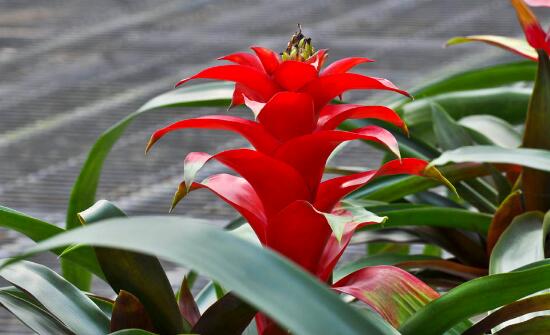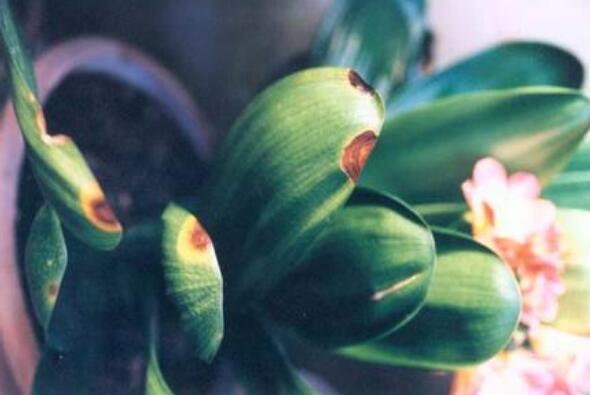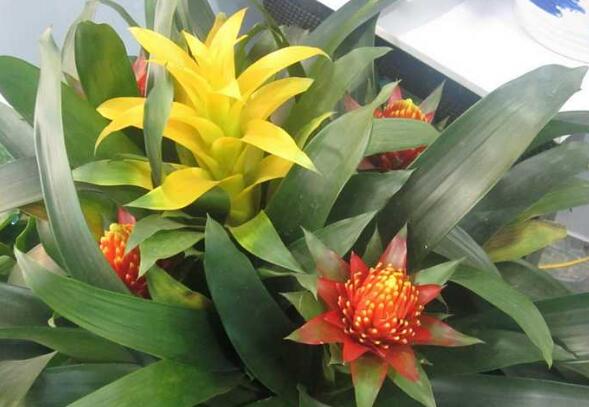What if there are insects in the flowers? pest control / drug spraying at the head of good luck
But its effect is amazing, not only can eat whitening, medicine can also cure all kinds of diseases, so many flower friends choose to raise it. However, in the process of breeding, because of improper maintenance, good luck will be plagued by insect pests, so what should we do when good luck grows bugs? The following is the prevention and control of diseases and insect pests in potted plants. There are 3 major insect pests and 3 major diseases. Let's go and have a look.
First, good luck when the head flowers grow bugs how to do, medicine spray

In the breeding methods and matters needing attention at the head of Hongyun, we introduced the aspects that need to be paid attention to in the process of its growth. once it is not up to the standard, the bugs will come to you. As for what to do when good luck grows bugs, find out which kind of worm it is, and then solve the problem. It is understood that there are three common insect pests at the head of good luck, as follows:
1. Crustaceans
This kind of insect is not only a pest of all flowers, but also one of the most common pests of good luck. It is very small, and it mainly harms the leaves of Hong Yun. In serious cases, the leaves will yellowing, withering and falling. This symptom generally occurs in cultivation sites with high humidity, poor ventilation and lack of sunlight.
Solution: a small amount of shell worms can be scraped off directly. When there are a large number of scale insects, insecticides can be used for spray control, such as 50% 1605 EC or 50% parathion.
2. Red spider
Red spider, one of the most common pests in Hong Yun, usually occurs in summer and mainly lives on the back of leaves or the base of leaf axils, and propagates very fast. Red spiders will prick and suck leaves, buds and flower and leaf juice, affecting the normal growth and development, not only affect the beauty, but also lead to the death of the whole plant.
Solution: when the red spider is small, it is difficult to find when there are few pests, once it is found that it can be washed with clean water; in severe cases, spray 1000 times dimethoate solution, once every 4 days, 2-3 times in a row.
3. Pocket moth
Plutella xylostella, one of the most common pests, mainly harms leaves and usually eats the mesophyll, leaving only a layer of transparent lower epidermis, which dries and falls into holes or gaps or breaks.
Solution: when this insect is found, many pesticides are used, such as trichlorfon, dichlorvos, dimethoate, dimethoate, malathion, fenitrothion and so on.
Second, the diseases at the head of good luck and their solutions
Lucky luck when the head flowers grow bugs how to do, read the above content we should know it! However, in addition to being attacked by insects, the disease is always harmful to good luck, and there are three main diseases, namely, heart rot, root rot and leaf tip yellowing. The specific symptoms and solutions are as follows:
1. Heart rot
Heart rot is caused by fungi, which is one of the common diseases at the head of good luck. After changing the disease, the tissue at the base of the head tube becomes soft and rotten, with a bad smell, and the tube will fall down on its own after a long time.
2. Root rot
This is also one of the common diseases at the head of good luck. After this disease, the root tip of Hongyun became black and brown or rotted, and the lateral root did not grow, which affected the absorption of water and fertilizer, and the plant growth was slow and weak.
Prevention and control methods of heart rot and root rot: before the occurrence of the above diseases, you can spray 400 times of oxidizing frost manganese zinc or 400 times of ethyl phosphine aluminum to irrigate the leaf tube, once a month, three times in a row, can effectively prevent the occurrence of diseases. Once the emergence of heart rot and root rot, it is basically irreparable.
3. Yellowing and withering of leaf tip
Leaf tip yellowing is one of the common diseases in Hongyun. it is mainly due to improper watering, low air humidity and excessive fertilization, resulting in salt damage caused by too high salt in the plant soil. This is what we call physiological diseases, which we think are caused. In light cases, the leaves turn yellow, and in severe cases, the plants die directly.
Prevention and treatment: the disease is related to water, so our watering is very important, choosing the right water quality is more important. Try to choose water with less salt, water at home, and use it after exposure to the sun. Control the temperature and avoid the temperature angle to avoid frost damage.
Characteristics and brief introduction of crab claw orchid in Daquan
Crab claw orchid not only has high ornamental value, but also can decorate furniture, purify air and so on. Many people like to make it into a gondola and hang it at home. Let's take a look at it and see what attractive features crab claw orchids have.
Crab claw orchid pictures
1. The flower language of crab claw orchid
Crab claw orchid has the beautiful meaning of "turning the world" and "good luck".
2. The value and use of crab claw orchid
Ornamental value is the most important value of crab claw orchid. Because of its long stem growth and overhanging, it is often made as a hanging orchid placed in the windowsill, entrance and other places for interior decoration. Because the florescence of crab claw orchid can be controlled by adjusting the light, so the florescence of many crab claw orchids is controlled in October, which is an excellent choice for indoor potted flower culture in winter.
3. Morphological characteristics of crab claw orchid.
Crab claw orchid is an epiphytic shrubby succulent plant with no leaves and no thorns on its stem, mostly branched, usually bright green and sometimes a little purple.
The flower of crab claw orchid blossoms at the top of the branch, usually rose red, the two ends of the flower grow symmetrically, the whole flower is about 6-9 cm long.
Characteristics and brief introduction of crab claw orchid
1. Characteristics of crab claw orchid
Leaves: tender green, new stem nodes are reddish, sometimes a little purple.
Stem: the main stem is round, easy to Lignification, no leaves and no thorns on the stem, mostly branched, showing nodal shape.
Flower: blooming at the top of the branch, usually rose-red, growing symmetrically at both ends of the flower, about 6-9 cm long.
Fruit: pear-shaped, red, smooth.
2. Another name for crab claw orchid
Crab claw orchid is a shrubby succulent plant of cactus family, also known as "Christmas cactus", "crab claw lotus" and "icing on the cake".
Crab claw orchid is planted in most western countries during the "Christmas" period, so it is called "Christmas cactus" by Christian people.
3. Growth habits of crab claw orchid.
The cool and warm environment is the most suitable for the growth of crab claw orchid, and the loose soil with rich organic matter and good drainage permeability should be selected to cultivate crab claw orchid.
Its drought tolerance is good, but it is afraid of the high temperature and hot weather in midsummer, so it should be moved to a semi-hidden place for maintenance and keep the surrounding temperature between 20-25 ℃. If the temperature is about 15 ℃, the plant will enter a dormant state.
The growth of crab claw orchid does not need long light, and the flowering period can be controlled by regulating the light time. For example, if the light is kept for 8-10 hours a day, it can blossom in 2-3 months.
How to raise crab claw orchid
1. Watering
Crab claw orchid watering should not be too much, easy to rot roots, basin soil surface is completely dry before rewatering, about 1-2 Mondays, the time can choose before 10:00 or after 6 p.m.
2. Fertilization
Crab claw orchid like fertilizer, before flowering, about once a week to apply mature liquid fertilizer or compound fertilizer, bud period to apply 0.2% more potassium dihydrogen phosphate solution to promote flowering. Fertilizer should be applied along the edge of the basin, do not touch the leaves, it will cause leaf burns.
3. Lighting
Autumn sun intensity weakens, can give crab claw orchid 6-8 hours of light, other times can move it to a dark place, can promote it to quickly differentiate flower buds, bud gestation.
4. Shu Lei
Sometimes, the top of the stem node of crab claw orchid has 2-3 buds in the same time, and they may compete with each other for nutrition. At this time, it is necessary to sparse the buds, keep the largest buds, and choose all the rest. Only in this way can we ensure the balance of nutrients in the buds of each end node and make the flowers of crab claw orchid bloom more plump and beautiful.
5. Pruning
Crab claw orchid in the flower failure, in time to cut off the residual flowers, if you continue to keep will only waste nutrients. Count 3-4 stem nodes from the flowering place and cut them off, so that it can retain nutrients to give birth to the next flowering.
Control of common insect pests in crab claw orchid
1. Red spider
Prevention: often open windows for ventilation, spray water to increase air humidity, can prevent the occurrence of red spiders to a certain extent.
Regularly spray omethoate solution for sterilization, spray foliar once every 15 days.
Treatment: immediately scrape off the diseased leaves or remove the diseased leaves directly. In severe cases, spray with fenitrothion lotion.
2. Scale insects
Scale insects are white, and when they get sick, the leaves are covered with white bugs, which makes people creepy. There is no regular pattern of the disease, so it should be detected and treated as soon as possible.
Treatment: in the initial stage, scrape off the bamboo directly or rinse with clean water; in serious cases, spray with imidophos EC solution.
Through the above content, I believe everyone has a certain understanding of crab claw orchid. The fresh stems and leaves of crab claw orchid can detoxify and detumescence, and it is effective in the treatment of sores and mumps. It is now in great market demand. Flower growers can give it a try, which may bring high benefits.
- Prev

What to do with the growing insects of Cymbidium? pest control of Orchid / three insect pests and four diseases
No matter what plant it is, as long as it is kept indoors, it will inevitably be disturbed by diseases and insect pests. In the cultivation method of Cymbidium, we introduce that Cymbidium has to go to soil, light, temperature, fertilization and so on, but once these requirements are not up to the standard, Cymbidium will get sick and grow worms, what about the worms?
- Next

What about the insects growing in the pineapple flower? pest control of the pineapple flower / 3 insect pests and 3 diseases
The beauty of pineapple is reflected in the flower. After all, it only blossoms once a year. But because some flower friends maintain improperly, pineapple flowers will be infested by insects, resulting in a decline in ornamental, then how to grow bugs in pineapple flowers? In fact, there is no need to panic, we just need to find out what kind of pest it is, and then solve the problem.
Related
- Fuxing push coffee new agricultural production and marketing class: lack of small-scale processing plants
- Jujube rice field leisure farm deep ploughing Yilan for five years to create a space for organic food and play
- Nongyu Farm-A trial of organic papaya for brave women with advanced technology
- Four points for attention in the prevention and control of diseases and insect pests of edible fungi
- How to add nutrient solution to Edible Fungi
- Is there any good way to control edible fungus mites?
- Open Inoculation Technology of Edible Fungi
- Is there any clever way to use fertilizer for edible fungus in winter?
- What agents are used to kill the pathogens of edible fungi in the mushroom shed?
- Rapid drying of Edible Fungi

